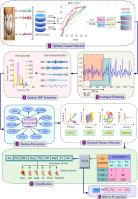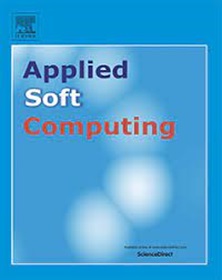使用肌电信号熵特征和高斯核 SVM 分类器的上肢假肢手势识别框架
IF 7.2
1区 计算机科学
Q1 COMPUTER SCIENCE, ARTIFICIAL INTELLIGENCE
引用次数: 0
摘要
本文提出了一种基于熵特征的新型多类 SVM 分类器框架,用于从表面肌电图(sEMG)信号预测经桡动脉截肢者的肢体运动。sEMG 信号面临的主要挑战是非线性、非稳态特征和易受噪声影响。因此,一个不受肌力水平变化影响的稳健有效的特征提取框架是基于 sEMG 的假肢控制的核心。为应对上述挑战,本研究利用变异模态分解(VMD)技术的潜力来识别 sEMG 信号的主要频率模态,并对分解后的 sEMG 模态进行频谱评估,以确定提取熵特征的主要模态。随后,我们评估了四种非线性优化特征选择技术的功效,并确定了突出的熵特征,以训练可预测手势的多类 SVM 模型。具体来说,为了处理非线性可分离的输入数据,本研究采用了一种名为径向基函数(RBF)的核化方法,它具有良好的泛化和噪声容限特性。我们使用公开的数据集测试了拟议框架的功效,这些数据集包含了经桡动脉截肢者和先天性截肢者的功能手势。针对具有动态力水平的各种手势获得的实验结果表明,所提出的框架对力水平变化具有很强的鲁棒性,分类准确率可达 99.07%。本文章由计算机程序翻译,如有差异,请以英文原文为准。

Gesture recognition framework for upper-limb prosthetics using entropy features from electromyographic signals and a Gaussian kernel SVM classifier
This paper puts forward a novel entropy features based multi-class SVM classifier framework to predict the limb movement of the transradial amputees from the surface electromyography (sEMG) signals. The major challenges with the sEMG signal are nonlinear and non-stationary characteristics and susceptibility to noise. Consequently, a robust and an effective feature extraction framework which is invariant to force level variations is central in sEMG based prosthesis control. To address the aforementioned challenges, this study leverages the potential of variational mode decomposition (VMD) technique to identify the prominent frequency modes of the sEMG signals, and performs the spectral evaluation of the decomposed sEMG modes to identify the dominant ones to extract the entropy features. Subsequently, we evaluate the efficacy of four nonlinear optimal feature selection techniques and identify the prominent entropy features to train the multi-class SVM model that can predict the gestures. Specifically, to handle the nonlinearly separable input data, this study implements a kernelization named a radial basis function (RBF), which has good generalization and noise tolerance features. The efficacy of the proposed framework is tested using the publicly available datasets that contain gestures from transradial and congenital amputees for functional gestures. Experimental results obtained for various gestures with dynamic force levels underscore that the proposed framework is highly robust against the force level variations and can achieve a classification accuracy of 99.07%.
求助全文
通过发布文献求助,成功后即可免费获取论文全文。
去求助
来源期刊

Applied Soft Computing
工程技术-计算机:跨学科应用
CiteScore
15.80
自引率
6.90%
发文量
874
审稿时长
10.9 months
期刊介绍:
Applied Soft Computing is an international journal promoting an integrated view of soft computing to solve real life problems.The focus is to publish the highest quality research in application and convergence of the areas of Fuzzy Logic, Neural Networks, Evolutionary Computing, Rough Sets and other similar techniques to address real world complexities.
Applied Soft Computing is a rolling publication: articles are published as soon as the editor-in-chief has accepted them. Therefore, the web site will continuously be updated with new articles and the publication time will be short.
 求助内容:
求助内容: 应助结果提醒方式:
应助结果提醒方式:


